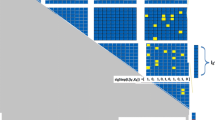Abstract
RNA secondary structure prediction by energy minimization is the central computational tool for the analysis of structural non-coding RNAs and their interactions. Sparsification has been successfully applied to improve the time efficiency of various structure prediction algorithms while guaranteeing the same result; however, for many such folding problems, space efficiency is of even greater concern, in particular for long RNAs and complex folding algorithms. So far, space-efficient sparsified RNA folding with fold reconstruction was solved only for simple pseudo-energy models. Here, we revisit the problem of space-efficient free energy minimization. Whereas the space-efficient minimization of the free energy has been sketched before, the reconstruction of the optimum structure has not even been discussed. We show that this reconstruction is not possible in trivial extension of the method for simple energy models. Then, we present the time- and space-efficient sparsified free energy minimization algorithm SparseMFEFold, which guarantees optimal structure prediction. In particular, this novel algorithm provides efficient fold reconstruction based on dynamically garbage collected trace arrows. We provide theoretical and empirical results on the efficiency of the method. SparseMFEFold is free software, available at http://www.bioinf.uni-leipzig.de/~will/Software/SparseMFEFold.
Access this chapter
Tax calculation will be finalised at checkout
Purchases are for personal use only
Similar content being viewed by others
Notes
- 1.
i.e., we replace the recursion \(L^p(i,j)\) by Eq. \((\hat{L}^p)\) and replace the symbol \(L^p(i,j)\) by \({\hat{L}}^p(i,j)\) in the recursion L.
References
Andronescu, M., Bereg, V., Hoos, H.H., Condon, A.: RNA STRAND: the RNA secondary structure and statistical analysis database. BMC Bioinform. 9(1), 340 (2008)
Backofen, R., Tsur, D., Zakov, S., Ziv-Ukelson, M.: Sparse RNA folding: time and space efficient algorithms. J. Discrete Algorithms 9(1), 12–31 (2011)
Dennis, C.: The brave new world of RNA. Nat. 418(6894), 122–124 (2002)
Dimitrieva, S., Bucher, P.: Practicality and time complexity of a sparsified RNA folding algorithm. J. Bioinform. Comput. Biol. 10(2), 1241007 (2012)
Hale, B.J., Yang, C.X., Ross, J.W.: Small RNA regulation of reproductive function. Mol. Reprod. Dev. 81(2), 148–159 (2014)
Hofacker, I.L., Fontana, W., Stadler, P.F., Bonhoeffer, S., Tacker, M., Schuster, P.: Fast folding and comparison of RNA secondary structures. Monatshefte Chemie 125, 167–188 (1994)
Jones, R., Lins, R.D.: Garbage Collection: Algorithms for Automatic Dynamic Memory Management. Wiley (1996)
Lorenz, R., Bernhart, S.H., Zu Siederdissen, C.H., Tafer, H., Flamm, C., Stadler, P.F., Hofacker, I.L.: ViennaRNA Package 2.0. Algorithms Mol. Biol. 6(1), 26 (2011)
Mathews, D.H., Sabina, J., Zuker, M., Turner, D.H.: Expanded sequence dependence of thermodynamic parameters improves prediction of RNA secondary structure. J. Mol. Biol. 288(5), 911–940 (1999)
Mattick, J.S., Makunin, I.V.: Non-coding RNA. Hum. Mol. Genet. 15(suppl 1), R17–R29 (2006)
Möhl, M., Salari, R., Will, S., Backofen, R., Sahinalp, S.C.: Sparsification of RNA structure prediction including pseudoknots. Algorithms Mol. Biol. 5(1), 39 (2010)
Nussinov, R., Jacobson, A.B.: Fast algorithm for predicting the secondary structure of single-stranded RNA. In: Proceedings of the National Academy of Sciences of the United States of America, vol. 77, issue no. 11, pp. 6309–6313 (1980)
Rastegari, B., Condon, A.: Parsing nucleic acid pseudoknotted secondary structure: algorithm and applications. J. Comput. Biol. 14(1), 16–32 (2007)
Salari, R., Möhl, M., Will, S., Sahinalp, S.C., Backofen, R.: Time and space efficient RNA-RNA interaction prediction via sparse folding. In: Berger, B. (ed.) RECOMB 2010. LNCS, vol. 6044, pp. 473–490. Springer, Heidelberg (2010)
Sankoff, D.: Simultaneous solution of the RNA folding, alignment and protosequence problems. SIAM J. Appl. Math. 45(5), 810–825 (1985). http://dx.doi.org/10.1137/0145048
Tinoco, I., Bustamante, C.: How RNA folds. J. Mol. Biol. 293(2), 271–281 (1999)
Wexler, Y., Zilberstein, C., Ziv-Ukelson, M.: A study of accessible motifs and RNA folding complexity. J. Comput. Biol. J. Comput. Mol. Cell Biol. 14(6), 856–872 (2007)
Zuker, M., Stiegler, P.: Optimal computer folding of large RNA sequences using thermodynamics and auxiliary information. Nucleic Acids Res. 9(1), 133–148 (1981)
Zuker, M., Sankoff, D.: RNA secondary structures and their prediction. Bull. Math. Biol. 46(4), 591–621 (1984). http://dx.doi.org/10.1007/bf02459506
Author information
Authors and Affiliations
Corresponding author
Editor information
Editors and Affiliations
Rights and permissions
Copyright information
© 2015 Springer-Verlag Berlin Heidelberg
About this paper
Cite this paper
Will, S., Jabbari, H. (2015). Sparse RNA Folding Revisited: Space-Efficient Minimum Free Energy Prediction. In: Pop, M., Touzet, H. (eds) Algorithms in Bioinformatics. WABI 2015. Lecture Notes in Computer Science(), vol 9289. Springer, Berlin, Heidelberg. https://doi.org/10.1007/978-3-662-48221-6_19
Download citation
DOI: https://doi.org/10.1007/978-3-662-48221-6_19
Published:
Publisher Name: Springer, Berlin, Heidelberg
Print ISBN: 978-3-662-48220-9
Online ISBN: 978-3-662-48221-6
eBook Packages: Computer ScienceComputer Science (R0)




